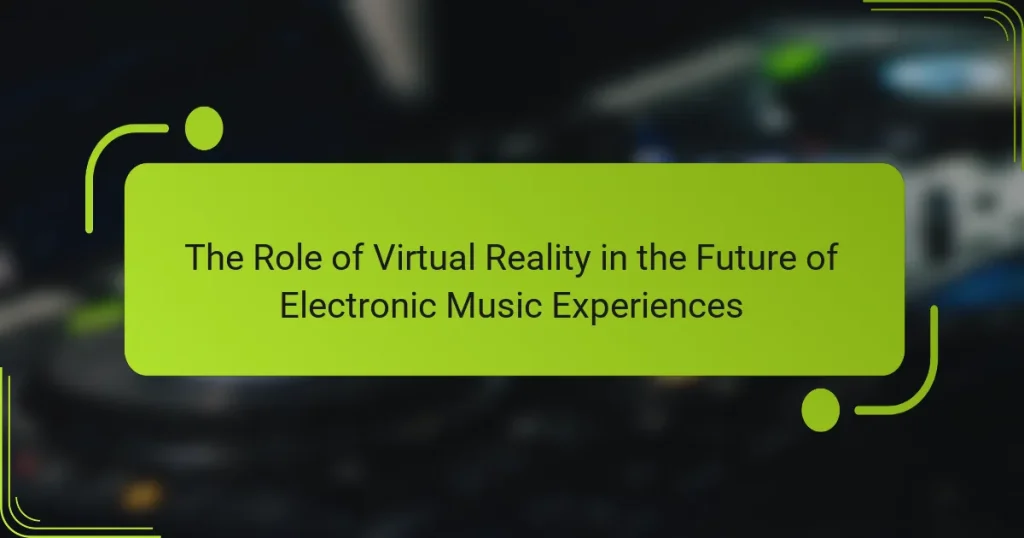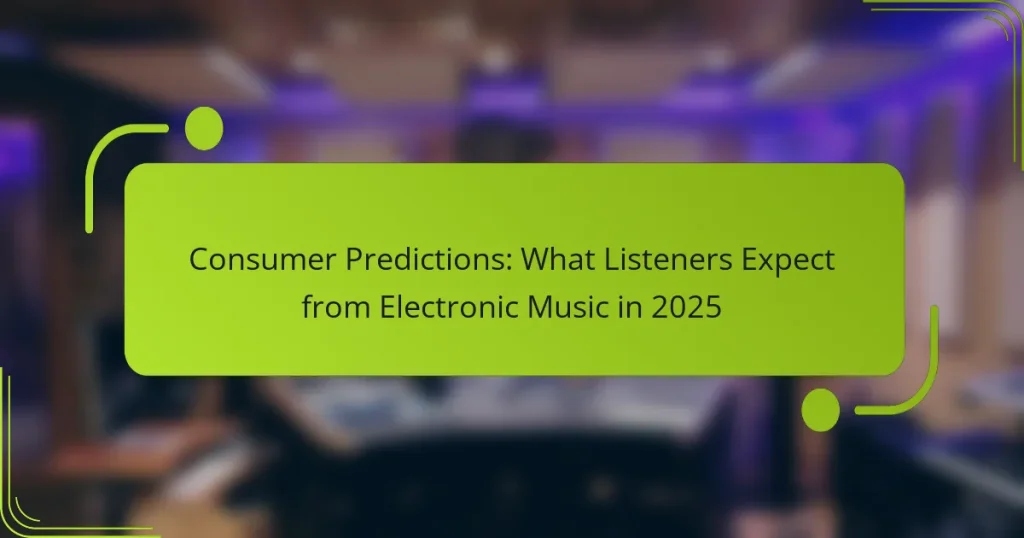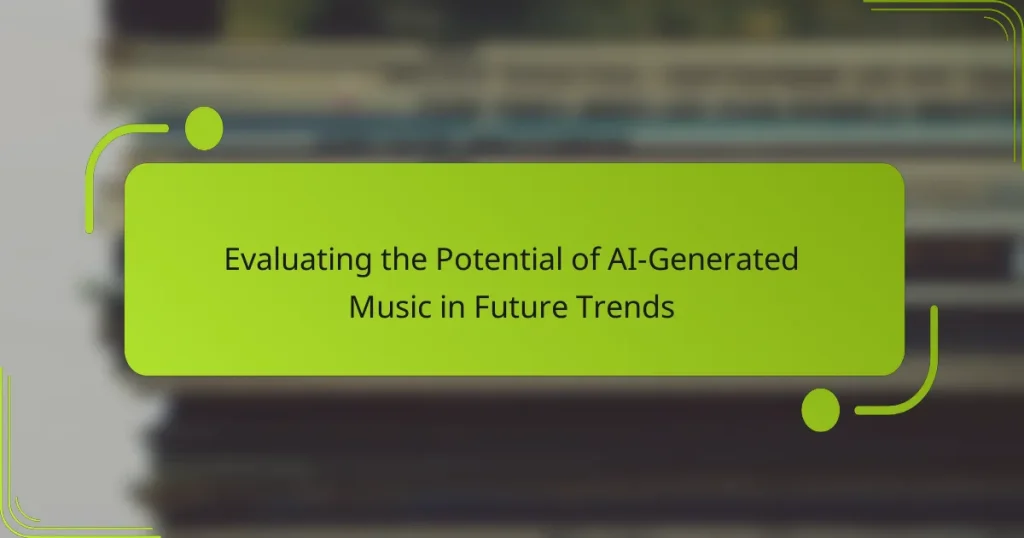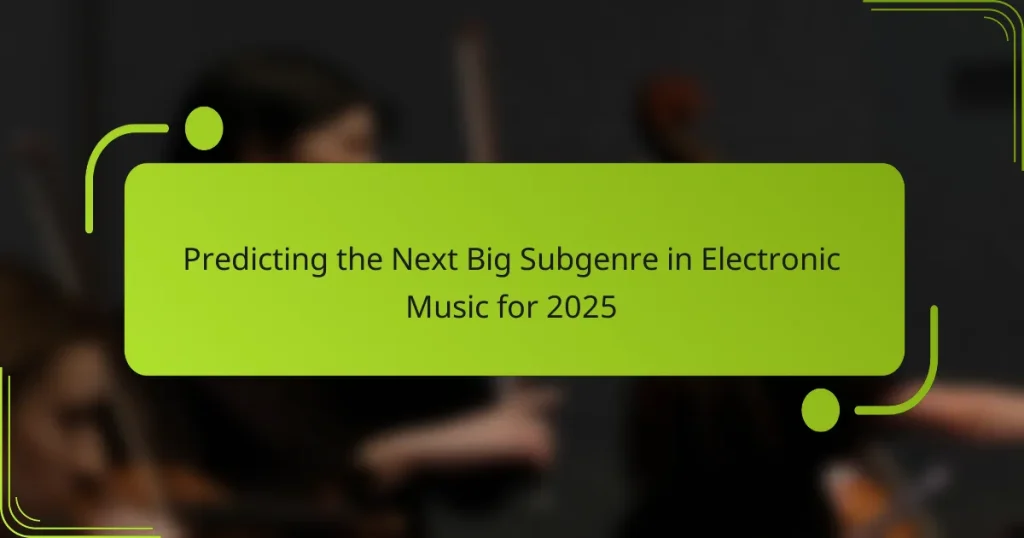The future of electronic music is poised for transformation, driven by rapid technological advancements and shifting listener preferences. Innovations such as artificial intelligence in music production and virtual reality concerts are set to redefine the way artists create and share their work, while emerging genres continue to captivate audiences with fresh sounds and experimental techniques.
Analyzing Current Trends to Forecast Future Electronic Music Popularity
How Global Events Could Influence Electronic Music Trends in the Next Decade
The Role of Virtual Reality in the Future of Electronic Music Experiences
Consumer Predictions: What Listeners Expect from Electronic Music in 2025
Evaluating the Potential of AI-Generated Music in Future Trends
Predicting the Next Big Subgenre in Electronic Music for 2025
What are the future trends in electronic music?
The future of electronic music is shaped by technological advancements and changing consumer preferences. Key trends include the integration of artificial intelligence in music production, the rise of virtual reality concerts, and the emergence of decentralized music platforms.
Increased use of AI in music production
Artificial intelligence is transforming music production by automating tasks and enhancing creativity. AI tools can analyze vast amounts of data to generate melodies, harmonies, and even entire compositions, allowing artists to focus more on their creative vision.
Producers can use AI-driven software to suggest chord progressions or mix tracks, significantly reducing production time. However, it’s essential to maintain a balance between human creativity and AI assistance to ensure the music retains its emotional depth.
Growth of virtual reality concerts
Virtual reality (VR) concerts are becoming increasingly popular, offering immersive experiences that traditional venues cannot match. These concerts allow fans to attend live performances from anywhere in the world, enhancing accessibility and engagement.
Artists can create unique environments and experiences that resonate with their audience, such as interactive visuals and personalized avatars. While VR technology is still developing, its potential to revolutionize live music experiences is significant, making it a trend to watch in the coming years.
Rise of decentralized music platforms
Decentralized music platforms are gaining traction as artists seek more control over their work and revenue. These platforms leverage blockchain technology to enable direct transactions between creators and listeners, eliminating intermediaries.
This shift allows musicians to retain a larger share of their earnings and engage with fans in new ways. However, artists must navigate the complexities of blockchain technology and ensure they understand the implications of using these platforms for distribution and copyright management.
How will technology shape electronic music?
Technology will significantly influence the evolution of electronic music by enhancing creativity and streamlining production processes. Innovations in software and digital platforms will enable artists to explore new soundscapes and monetize their work more effectively.
Advancements in sound design software
Recent advancements in sound design software have revolutionized how electronic music is created. Tools like synthesizers and samplers are becoming more sophisticated, allowing for intricate sound manipulation and layering. Artists can now access a wide range of virtual instruments that mimic real-world sounds or create entirely new ones.
Popular software options include Ableton Live, FL Studio, and Logic Pro, each offering unique features that cater to different styles and workflows. These platforms often include built-in effects and plugins that enhance sound quality and offer creative possibilities.
Integration of blockchain for royalties
The integration of blockchain technology in the music industry is transforming how artists receive royalties. By using smart contracts, musicians can ensure they are paid fairly and transparently whenever their music is streamed or sold. This technology eliminates intermediaries, allowing for direct transactions between artists and fans.
Platforms like Audius and Ujo Music are pioneering this approach, enabling artists to retain ownership of their work while receiving a larger share of the revenue. As blockchain adoption grows, it could lead to more equitable compensation models in the electronic music landscape.
What are the emerging genres in electronic music?
Emerging genres in electronic music reflect a blend of innovative sounds and evolving production techniques. Notable trends include the rise of lo-fi beats and the expansion of ambient and experimental styles, each attracting dedicated audiences and reshaping the musical landscape.
Popularity of lo-fi electronic beats
Lo-fi electronic beats have gained significant traction, particularly among younger listeners and in online platforms like YouTube and Spotify. Characterized by their mellow, relaxed vibe, these tracks often incorporate elements such as vinyl crackle and soft instrumentals, making them ideal for studying or relaxing.
Producers can create lo-fi beats using simple software and affordable equipment, making it accessible for many aspiring artists. The genre’s appeal lies in its authenticity and the emotional connection it fosters, often resonating with listeners seeking comfort in music.
Expansion of ambient and experimental sounds
Ambient and experimental electronic music are increasingly popular, pushing the boundaries of traditional genres. These styles focus on creating immersive soundscapes that evoke emotions and transport listeners to different environments, often incorporating field recordings and unconventional instruments.
Artists in this space frequently experiment with structure and form, leading to unique listening experiences. The rise of digital platforms has facilitated the sharing of these innovative sounds, allowing niche artists to reach global audiences and collaborate across genres.
How will audience engagement evolve in electronic music?
Audience engagement in electronic music is set to become more immersive and interactive, leveraging technology to create deeper connections between artists and fans. As platforms evolve, the ways in which audiences participate in live events and collaborate with artists will significantly change.
Interactive live streaming experiences
Interactive live streaming experiences allow fans to engage with performances in real-time, often through platforms that support viewer participation. Features like live polls, chat interactions, and virtual reality environments can enhance the experience, making audiences feel like active participants rather than passive viewers.
Artists can use these tools to tailor their performances based on audience feedback, creating a unique experience for each event. For example, a DJ might adjust the setlist based on live reactions, fostering a sense of community and shared experience among viewers.
Use of social media for fan collaboration
Social media is increasingly being used for fan collaboration in electronic music, allowing fans to contribute ideas, remixes, or even lyrics. Platforms like Instagram and TikTok enable artists to solicit input directly from their audience, creating a collaborative atmosphere that can enhance fan loyalty.
For instance, an artist might launch a challenge on social media, inviting fans to create their own versions of a track. This not only boosts engagement but also expands the artist’s reach as fans share their creations within their networks, potentially attracting new listeners.
What role will festivals play in the future?
Festivals will continue to be a vital part of the electronic music landscape, serving as platforms for artists to connect with fans and showcase new sounds. They will evolve by integrating technology and addressing social issues, ensuring they remain relevant and engaging.
Hybrid events combining physical and digital
Hybrid events will blend in-person experiences with digital components, allowing broader participation. Attendees can enjoy live performances while also accessing virtual content, such as backstage footage or interactive Q&A sessions.
This format caters to diverse audiences, enabling those unable to travel to still engage with the festival. It also opens up new revenue streams through ticket sales for both physical and virtual attendance.
Focus on sustainability in festival planning
Sustainability will be a key focus in future festival planning, as organizers strive to minimize environmental impact. This includes using renewable energy sources, reducing waste, and promoting eco-friendly practices among attendees.
Festivals may implement measures such as digital ticketing to cut down on paper use and encourage public transport or carpooling to reduce carbon footprints. Engaging with local communities to support sustainable initiatives can also enhance a festival’s reputation and attract environmentally conscious attendees.
What are the implications of globalization on electronic music?
Globalization significantly influences electronic music by facilitating cross-border collaborations and expanding access to diverse musical styles. This interconnectedness allows artists to blend genres and reach wider audiences, reshaping the landscape of electronic music worldwide.
Cross-cultural collaborations
Cross-cultural collaborations in electronic music are becoming increasingly common, as artists from different backgrounds work together to create innovative sounds. These partnerships often lead to unique fusions of traditional and modern elements, enhancing the richness of the genre. For example, a producer from Europe might collaborate with a vocalist from Africa, resulting in a track that incorporates both electronic beats and indigenous rhythms.
To maximize the benefits of these collaborations, artists should be open to experimenting with new styles and techniques. Engaging with local music scenes can also provide valuable insights and inspiration, fostering creativity and authenticity in their work.
Influence of global music markets
The influence of global music markets on electronic music is profound, as streaming platforms and social media enable artists to reach international audiences. This accessibility allows for a greater exchange of ideas and trends, which can lead to the emergence of new sub-genres and styles. For instance, the rise of Afro-house has been fueled by the popularity of African artists on global platforms.
Artists should consider the dynamics of different markets when promoting their music. Understanding regional preferences and trends can help tailor their sound and marketing strategies effectively. Additionally, leveraging data analytics from streaming services can provide insights into audience demographics and listening habits, guiding future releases.






